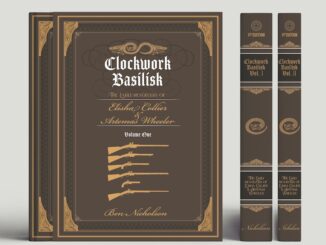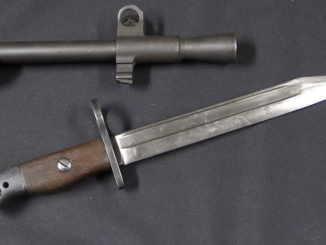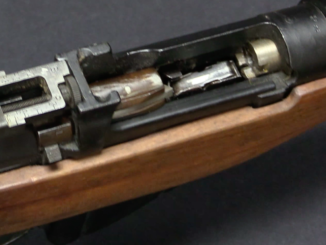The Puckle Gun is probably best known as that thing that had round bullets for Christians and square bullets for Turks, but there is much more to it than just that (and in addition, the square bullet version was never actually built). James Puckle designed it in 1718 as a naval defensive weapon to help British vessels fight back against Ottoman pirates using fast and nimble small boats that could not be effectively engaged with large cannon. Puckle’s gun was a 9-shot repeater of about 1.25″ bore on a flexible swiveling mount which could easily track the fastest marauder.
The Puckle is basically a manual revolver, but its firing mechanism incorporates some clever functionality to allow a fast and smooth rate of fire. The gun was demonstrated in public in 1721 (after being turned down by the Royal Navy) and fired 63 shots in 7 minutes – quite the feat at that time! The only sale appears to have been a private purchase of two guns for an expedition to the West Indies, however.
Thanks to the Institute of Military Technology for allowing me to have access to this magnificent piece and bring it to you!




Nice work, Ian.
…Ooo, Ooo, Ooo ! I know where the other one is. It’s in the military museum downtown Beijing . Third floor. They prohibit photographs, but I seen it.
..when do I get my chicken dinner ?
wow, I would love to see that thing. you are very lucky dude.
Is the barrel totally brass? Does it have rifling?
“totally brass”
Possible https://en.wikipedia.org/wiki/Cannon states that
Field artillery cannon in Europe and the Americas were initially made most often of bronze, though later forms were constructed of cast iron and eventually steel. Bronze has several characteristics that made it preferable as a construction material: although it is relatively expensive, does not always alloy well, and can result in a final product that is “spongy about the bore”, bronze is more flexible than iron and therefore less prone to bursting when exposed to high pressure; cast iron cannon are less expensive and more durable generally than bronze and withstand being fired more times without deteriorating. However, cast iron cannon have a tendency to burst without having shown any previous weakness or wear, and this makes them more dangerous to operate.
Here is nice review on concerned materials; of course this is modern up-to date specification unavailable in 18th century.
As you say, bronze stands above anything incl. steel except for tensile strength. Brass on the other hand is supremely easy to machine.
http://alubra.com/pdf/catalog.pdf
I should have said: “cast iron” instead of steel.
…I can’t remember what it was made of. It’s set up on a tripod . It was in need of a real good cleaning. I wish I’d sneaked a photo.
Cool Ian,
You found a revolver with a quick-change cylinder.
Even better that it is a century – or so – older than expected.
Amazing how much effort Puckle devoted to making the feed mechanism “sailor-proof.”
Also clever how Puckle used tapered chambers to reduce blow-back. I wonder if a forward-facing cones would further reduce blow-back?????
As for balance, I suspect that it would balance perfectly when fully loaded … all the better to traverse quickly against fast-moving pirates.
Speaking of pirates, … limking 18th century pirates with modern Somali pirates. Is an excellent example of “Big History.”
As for forging square-bore barrels … would hammer-forging work? ….. Like recent H&K or Colt Canada barrels …..? What metal could Puckle have used for a mandrel?
Finally, did any more recent gunsmiths built pistols or rifles with quick-change cylinders?
Keep up the good work!
Well, on the quick change cylinder thing, several modern revolvers have had this feature.
Both the French Manhurin MR73 and an FN DA revolver had the ability to change cylinders from .357 Magnum/.38 Special to 9 x 19mm in about twenty seconds with no tools required.
The Ruger Convertible Single-Six .357/9mm is probably the best-known example of the “cylinder-switching” breed, along with the smaller Bearcat Convertible .22 WMRF/.22 LR “switch-cylinder” single-action.
Ruger also had large-frame Super Blackhawk single actions that did the same trick, in .44 Magnum/.44-40 WCF, .45 Colt/.45 ACP, and .38-40 WCF/.40 S&W.
One peculiar one is the S&W 610 in 10mm Auto. It doesn’t have a changeable cylinder, but it uses half-moon clips to ensure correct headspace for the rimless 10mm rounds, like an old M1917 in .45 ACP.
You can use the .40 S&W in it with the half-moon clips, as well. As long as headspace is correct, it’s pretty much like firing a .38 Special in a .357 Magnum.
cheers
eon
Pretty much all of the Ruger single action 22 revolvers over the past 30- 40 years or more came with both 22 Mag and 22 LR cylinders. Not trying to be nit-picky, it is an aggravation to me as I have an early “flat gate” Single Six and would rather have one of the later ones that came with the 22 Mag cylinder.
“quick change cylinder thing”
Also, first revolver made by S&W known as S&W Model 1 has cylinder which can be easily removed, in fact standard procedure assume cylinder removal for reloading
https://en.wikipedia.org/wiki/Smith_%26_Wesson_Model_1
For square barrels (square on the interior, that is), nothing would really work: the corners of the square are too good at being stress risers, unless you rounded them off so much as to get a nearly octagonal profile. (Google “stress risers” if you don’t know the term.) Even today, the challenges would be hard to manage; and in 1721 — well, the Pickle gun obviously has lathe-turned surfaces, including a screw thread, but Maudslay’s lathe (“the first industrially practical screw cutting lathe”) came out in 1800 or so. Obviously people were cutting threads before that, but the process must have been heinously time-consuming and expensive. So even as it was, the Pickle gun was going way out on a limb technologically.
If you look up the Fox Fire books, I think it is in book 5 that shows how flintlock rifles were rifled without a lathe. The Fox Fire books were written by an English teacher and his students as they documents the old ways of life in Appalachia.
A strip of metal was forged around a mandrel, then a steel cutter was used to cut the rifling after the mandrel was removed. The cutter was guided by a wooden screw of sorts. How the screw was made, by hand with surprising accuracy, is an idea so clever that no one these days would think of it.
Regardless of the feasibility of manufacture, it’s hard to imagine there being enough survivors of 30mm roundshot wounds that you’d find it necessary to “take the gloves off” and break out the square ones.
In his book The Great Guns, Harold L. Peterson in writing about the original breechloading Dreyse needle rifle described its rifling as “four-groove with grooves so deep the bore was almost square”.
In the same book, he described “novelty guns” made during the 17th and 18th Centuries in Europe, such as mini-flintlocks built into knife-and-fork sets. At least one such “plaything”, a wheel-lock rifle, had a heart-shaped bore, fired heart-shaped bullets cast in a special mould, and achieved a “rifling” effect by having a literally twisting bore.
Then of course there was the pistol with a glass barrel. No, really.
The moral is that just because something’s fairly silly doesn’t mean somebody hasn’t tried it at least once.
PS; if you check out Edwin Tunis’ old book Weapons (1954), on page 103 he has a beautiful woodcut-style illustration of the type of rifling bench used to do the bores on Pennsylvania rifles, plus a description of how the cutter was made and used.
cheers
eon
“Be not frightened of this horrible machine.
They are only wounded who have shares therein”
This describes well the economic success of the Puckle gun.
Some times ideas and inventions are just too far ahead of their times. The 6mm Lee Navy rifle comes to mind here, as well as the electric powered Gatling gun.
Still, very cool. I can see why the military at the time thought it too complicated. I understand it was some times loaded with buckshot. This would presumably work better than square bullets.
Does the phrase riot control come to mind when you load buckshot? Protesters with clubs and picket signs (along with small pirate boats) are the only targets unable to fight back without getting riddled with holes… or am I wrong?
“6mm Lee Navy rifle”
This rifle, as straight-pull was indeed modern, cartridge was of small caliber, but notice that it does NOT use Spitzer bullet and (less importantly) has semi-rimmed case.
“electric powered Gatling gun”
Considering technology available at moment when Gatling gun was patented (1860s), there was no way to provide light enough external power supply for stand-alone gun and also it would complicate logistic.
Electric motor need voltage, only then available rechargeable battery was plumbum-based battery, which is (by modern standard) heavy (poor capacity-to-mass ratio), see: https://en.wikipedia.org/wiki/Lead–acid_battery
Amazing technology and machine work for the time!
Also, it was specifically called both a “mechanical gun” and a “machine gun” in Puckle’s ad broadsides.
So we may actually consider him as having coined the term “machine gun” for a rapid-fire weapon.
cheers
eon
Didn’t the patent show a partial diagram of the muzzle of a square bored version? Yea or nay, it’s a beautiful piece of workmanship. Imagine a Puckle firing small, explosive shells like a Maxim pom-pom.
Had explosive shells for the Puckle existed, they would first require chemical priming of some sort. Remember that exploding cannon balls weren’t a really great idea prior to percussion caps.
This show fits integrally into previous – with 300 years of jump in development. I have couple of additional questions/ confirmations:
Is drum rotated solely by hand? How is this easy/ difficult to do with hot drum?
Further I’d wonder if anyone tried to “mechanize” chambers transfer (perhaps thru cam operated by second crank). The current crank appears to primarily lock/ unlock chambers; not to rotate them. I know, it may get little too complex mechanically. But, if possible, it would be close to real MG.
Overall, as usual for me I observe level of material working and their finishes – they are excellent.
I hope there is more from this place. the website looks like they have a large amount of Stoner and Armalite designs that didn’t make it past prototype.
An original Puckle Gun is displayed in the “Buckler’s Hard” museum (one of several on the estate of Lord Montagu at Beaulieu in Hampshire – his predecessor financed the expedition mentioned to fund expansion of his estate but it apparently failed because the French had already claimed St Lucia and St Vincent by the time they arrived!).
I took a photo of the surviving gun a few years ago when I visited:
http://i196.photobucket.com/albums/aa316/brickie501/History/2013-08-30_zpsi80zoxsj.jpg
… plus the accompanying description of the weapons and the expedition for which they were purchased (not a great picture but you can hopefully see most of the detail):
http://i196.photobucket.com/albums/aa316/brickie501/History/2013-08-30%2013.06.18_zps14ubwtzl.jpg
As you can see, the gun is (was?) on completely open display and complete with a spare cylinder; hope this is of some interest…
Gotta love a puckle.
Well, I knew it was only a matter of time before Ian did a video on the Puckle gun! I fortunately know the Puckle gun well and also this specific gun as I sourced it for the IMT back in 2014. There is a very interesting back story on the search for an example for IMT and this gun in particular… I contacted IMT back in 2013 as I wanted to know if they had SN# 2 & 3 AR15 prototypes as I had photographed them for the Collector Grade Publications book “The Black Rifle” back in the 1980’s when they were in the Sidem Collection here in the UK (they are now back in the US). The reply I got was ‘do you know where we can get a Puckle gun from’ !!! Well, I knew the Pattern Room collection had one but it was on loan from the armoury of His Grace the Duke of Buccleuch & Queensberry and was returned to his collection when the Pattern Room (and RSAF Enfield) moved to Nottingham as part of BAE Systems. The former Pattern Room collection (now the NFC in Leeds) has a 1/5th scale model now to show the mechanism, etc. The Danish “Tøjhusmuseet” (Army Museum) has one but have lost it in their storage archives and don’t call it a Puckle gun and therefore cannot find it in their inventory! So the only know surviving Puckle guns are two in the Duke of Buccleuch collection and a replica in the bucklers Hard Maritime Museum (all in the UK) and the single example ‘lost’ in the Danish “Tøjhusmuseet” (Army Museum)
Vic: “So the only know surviving Puckle guns are two in the Duke of Buccleuch collection and a replica in the bucklers Hard Maritime Museum (all in the UK) and the single example ‘lost’ in the Danish “Tøjhusmuseet” (Army Museum)”
Actually, I think the one I photographed at the Buckler’s Hard Museum is an original – one of the two from the Duke of Buccleuch collection; at least there is a note to that effect at the bottom of the information board (sorry, that part is not very clear in my photograph).
As luck would have it, through some detective work on my part I found a photograph taken at a Belgian Arms Fair of a replica Puckle gun. I tracked down the owner/builder of the gun and wanted to ask if he could manufacture another example for IMT. Regrettably the gentleman had passed away some 6 months earlier and that avenue was lost. However through some negotiations with the gentleman’s family we explained that his work would be displayed and examined by many people at IMT and would have pride of place there in their reference collection and a an arrangement was struck. I went to Belgium and prepared the gun for shipping and met the owners wife. The builder was an engineer called Eric Baes, a fantastic engineer who had examined ‘all’ the surviving examples and made meticulous drawings and notes that were so accurate that the example in the video is ‘entirely’ his own work and not one original part is used in its construction… a fantastic testament to his skills! I had the gun in my possession here in the UK for some months and made lots of notes, photographs, and drawings of it and then shipped it to IMT where it has been ever since. I’m proud of the fact that I had some small part of this guns history and that I had the opportunity to showcase Eric’s work and skill…
BTW, there was a square chamber cylinder made back in the 1718 period as Eric photographed an original. It used the standard barrel though!
I have some additional photographs of this gun, I will sort out a link to them for anyone that is interested?
Vic,
Thanks for the additional information on this amazing reproduction! I for one would love to see any additional photos that you have. ^__^
Video of square bullets in flight, because of the internet.
https://www.youtube.com/watch?v=wFhqyvCTA1I
Seam to work well enough for Turks to me.
I played with the one in CPH like 6 years ago, before the closure. Interesting.